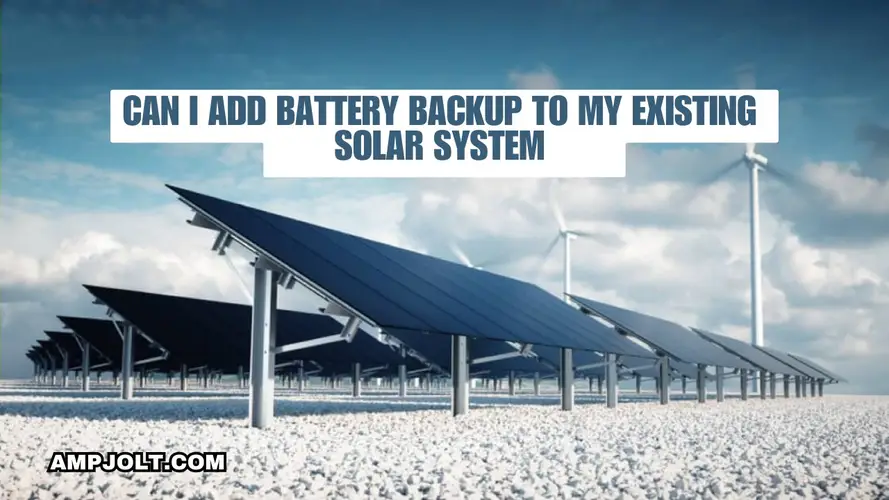How to change battery in garage door opener remot…
April 14, 2018

Solar energy systems have revolutionized how we harness power, offering sustainable and environmentally friendly solutions. Integrating battery backup systems becomes a compelling consideration for solar system owners as technology evolves.
Yes, adding battery backup to your existing solar system is possible. Ensure your solar inverter is compatible with a battery, and consider upgrading to a hybrid inverter if needed. Select a suitable battery system and consult a solar professional for a seamless integration that enhances energy storage and reliability.
This article explores the feasibility, benefits, and steps of adding battery backup to an existing solar setup.
While traditional solar systems generate electricity when the sun is shining, they cannot often store excess energy for later use. This limitation means that solar-powered homes may need to draw electricity from the grid during periods of low sunlight or at night.
Introducing a battery backup system addresses this issue, allowing homeowners to store surplus energy generated during sunny periods and use it when solar production is low or nonexistent.
Check if your existing solar inverter is compatible with a battery backup system. Some inverters are designed to integrate seamlessly with batteries, while others may require additional equipment or replacement.
Explore battery options that align with your solar system and inverter. Lithium-ion batteries, such as those used in electric vehicles, are famous for their energy density and longevity, but compatibility is crucial.
If your current inverter lacks compatibility, you might need to upgrade to a hybrid inverter designed for solar and battery integration. This investment facilitates efficient energy management.
Assess your solar panel capacity to determine if it can generate enough surplus energy to justify adding a battery backup system. An energy audit can help estimate your consumption and production patterns.

With a battery backup, you can reduce reliance on the grid during periods of low solar production, promoting energy independence.
Store excess energy generated during peak sunlight hours for later use, ensuring a continuous power supply even when the sun isn't shining.
In a grid outage, a battery backup system can keep your essential appliances running, enhancing resilience and providing peace of mind.
Optimize your energy consumption using stored solar energy during peak electricity rate hours, potentially saving utility costs.
Conduct a thorough assessment of your existing solar system, including the inverter, solar panels, and energy consumption patterns.
Upgrade to a hybrid inverter or replace your existing inverter with one designed for solar and battery integration.
Choose a suitable battery system based on capacity, voltage, and compatibility with your solar setup.
Hire a qualified solar technician for the installation. This ensures compliance with safety standards and optimizes system performance.
Configure the system settings to enable seamless communication between the solar panels, inverter, and battery for efficient energy management.
Conduct thorough testing to ensure the system operates as intended. Optimize settings for maximum efficiency and performance.
The cost of adding a battery backup system varies based on factors such as the battery's capacity, the type of inverter, and installation charges. While the initial investment may seem significant, the long-term savings on utility bills and the added resilience during power outages can make it worthwhile.
Maintaining a solar battery backup system ensures optimal performance and longevity. Regular checks and proactive measures can contribute to the efficiency and reliability of the system. Here's a comprehensive guide on the maintenance required for a solar battery backup system:
Conduct routine checks on the overall performance of the solar battery backup system. Monitor energy production, storage, and discharge patterns. Any unusual fluctuations should be investigated promptly.
Keep a close eye on the health of the solar batteries. Monitor parameters such as state of charge, voltage levels, and overall capacity. Modern battery systems often come with built-in monitoring capabilities.
Ensure proper ventilation and temperature management for the batteries. Extreme temperatures can affect battery performance and lifespan. Implement cooling or heating systems to maintain an optimal operating temperature if necessary.
Regularly inspect the solar inverter, as it plays a crucial role in converting your home's DC power from the solar panels to AC power. Check for any signs of wear, loose connections, or damage.
Keep the solar panels clean to maximize energy production. Regularly remove dirt, dust, leaves, and any other debris that may accumulate on the panels. Clean panels contribute to better efficiency.
Stay updated with any software releases or updates the solar battery system manufacturer provides. These updates may include improvements in performance, monitoring features, and bug fixes.
Periodically run system diagnostics to identify and address any potential issues. This may include running tests on the battery, inverter, and other components to ensure they operate within optimal parameters.
Conduct visual inspections of all components, including wiring and connections. Look for signs of wear, corrosion, or damage. Address any issues promptly to prevent further damage. It would help if you also read How to change battery in garage door opener keypad.
Prioritize safety by checking for any loose or exposed wires. Ensure that the electrical components are securely fastened and that the system has no potential hazards.
Plan for battery replacements within the expected lifespan of the batteries, typically around 10-15 years. Regular monitoring can provide insights into the degradation of battery performance over time.
Schedule periodic professional inspections by qualified technicians. Professionals can conduct in-depth assessments, identify potential issues, and perform necessary maintenance tasks.
Develop a plan for handling emergencies or power outages. Ensure that your solar battery backup system has a reliable backup power source or generator in case of extended outages.
Adding a battery backup system to your existing solar setup is a strategic step toward achieving greater energy autonomy. As technology advances and prices become more competitive, the integration of solar and battery systems is increasingly accessible to homeowners. Assessing compatibility, understanding the benefits, and following a systematic approach to installation can empower you to enhance the efficiency and reliability of your solar energy system. Embrace the future of sustainable energy with the synergy of solar power and battery backup.
Yes, adding a battery backup to an existing solar system is possible. However, compatibility checks and potential upgrades to the inverter may be required.
Lithium-ion batteries, such as those used in electric vehicles, are famous for solar backup. They offer high energy density and longer life but should be selected based on compatibility.
If your current inverter isn't designed for battery integration, you may need to upgrade to a hybrid inverter or replace it with a compatible one.
A battery backup allows you to store excess solar energy during periods of low sunlight or grid outages, providing continuous power and reducing reliance on the grid.
A battery backup can optimize your energy consumption, allowing you to use stored solar energy during peak electricity rate hours and potentially saving on utility costs.
A qualified solar technician should do the installation of a battery backup system to ensure safety, compliance with standards, and optimal system performance.
In many cases, it is possible to expand the battery capacity of your solar backup system. However, compatibility with the existing components should be confirmed, and professional advice is recommended.
Comments
Write a comment